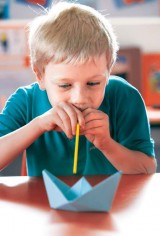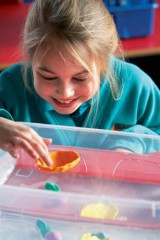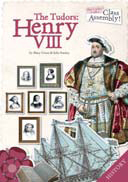The Tudors is typically taught in KS2, but there’s no reason why Henry VIII’s favoured warship cannot spark excitement in younger children..
The Mary Rose sank in 1545 and her remains were lost for over four centuries. It can be a difficult topic at KS1 as the events of the ship’s sinking took place a long time ago and involved the deaths of many people. However, the surviving artefacts can reveal a great deal about the past and there is much in the story of her recovery to inspire exciting learning with young children.
Children will need to understand that the Mary Rose was a warship built a long time ago. A first activity might be to show the children a picture of the Mary Rose alongside one of a modern warship, to scale if possible. The children should discuss (and note down if appropriate) the similarities and differences between the ships. These will include size, construction materials and the masts and sails of the Mary Rose.
It would also help an appreciation of how long ago the Mary Rose sailed to look at pictures of soldiers and sailors (both were on board) then and now, and of everyday people in Tudor and modern times. Again, a similarity and difference activity would work well here. There are many good pictures of what the crew might have looked like on the Mary Rose website (maryrose.org/lcity).
A game of port and starboard in the hall is a great way to give the children a feel for life on board a sailing ship. The children should already have seen pictures of the Mary Rose and gained some understanding of the different decks, ladders, cannon etc. In a large space, give them a different action for each instruction you call out. Here are some to start you off:
• Climb the rigging
• Haul the anchor
• Scrub the decks
• Captain’s coming
• Ready the cannon
• Archers ready
On the instruction “To the orlop deck!”, “To the hold!” or “To the weather deck!”, the children should mime climbing a ladder to get there. On the instruction “Port!” they all run to the left side, “Starboard!” to the right, “Forecastle!” sends them to the front of the ship and “Sterncastle!” to the rear. If you want to play a competitive game, the last one/s to follow each instruction accurately are out.
 Hopefully the initial discussions prompted by the picture of the ship elicited questions about the sails and masts and what they were for. This could lead to activities exploring wind power. Children could be asked to think about what happens on a windy day, which things blow around in a light wind and what can happen in a strong wind. Video clips might be helpful to illustrate this.
Hopefully the initial discussions prompted by the picture of the ship elicited questions about the sails and masts and what they were for. This could lead to activities exploring wind power. Children could be asked to think about what happens on a windy day, which things blow around in a light wind and what can happen in a strong wind. Video clips might be helpful to illustrate this.
Children could try moving things by blowing them. Collect small objects like toy cars, plastic figures and origami paper boats. Ask the children to line them up and see which is moved by wind power most easily. They could try blowing them through straws or flapping newspapers to make them move.
After the activity, see if the children can come up with ideas as to which objects were moved best by wind power and why they think this was. Can they identify that both weight and shape are likely to be significant? Can they find ways to make a piece of A6 paper travel best by wind power? Children should explore what happens if the paper lies flat on a surface, if it is scrunched into a ball or if it is held up vertically. They can then use what they have discovered to create their ‘best wind powered’ shape.
 Floating and sinking are fascinating concepts for children to explore, but difficult – even for adults – to explain. Allow the children lots of time to investigate how different materials behave in water and, more importantly, how their shape affects their behaviour. This is a great opportunity for children to develop their observational and descriptive skills too.
Floating and sinking are fascinating concepts for children to explore, but difficult – even for adults – to explain. Allow the children lots of time to investigate how different materials behave in water and, more importantly, how their shape affects their behaviour. This is a great opportunity for children to develop their observational and descriptive skills too.
Start with a container of water and lots of different shaped and sized objects made from different materials. Before putting each object in the water, children should predict what they think the object will do and why. Will it float? Partially submerge? Sink slowly? Sink very quickly? This will give them lots of opportunities to discuss what they already know or believe.
Next, give the children a ball of modelling material. What happens when the ball is placed in the water? How could they change the shape of the modelling material so that it floats? Allow them plenty of time to experiment for themselves. Can they explain why a boat shape floats? (An object will float if it is lighter than the amount of water it pushes out of the way. A ball of plasticine will sink, but if it is transformed into a boat shape, it pushes more water out of the way and so will float.)
Having created their floating boat of modelling material, how many small objects – such as Lego bricks – can children carefully put in before it sinks? Would a bigger boat made of the same kind of modelling material hold more cargo? Each time, ask the children to predict and give their reasons (e.g. “It will sink because the biggerboat is heavier”, “But it’s bigger so it will push more water out of the way. That means it will float better and take a heavier load”).
Children will enjoy some underwater archaeology of their own. Show them video clips of the archaeologists excavating the Mary Rose. YouTube has some interesting footage of later excavations carried out between 2003 and 2005 where you can see the divers preparing, going under water, bringing up small finds and entering the details on a database. Discuss why it is important for the divers to mark exactly where things have been found and to record what they look like.
Place objects in a large sand or water play tray and cover with sand and water. Allow the children to dig and brush away the sand carefully to find what has been buried and then record it carefully on record sheets or the computer. This can be an ongoing activity. If you want to create a sense of mystery you could include items that would build up into evidence of what sank and who it belonged to. The children could make deductions based on their finds and perhaps speculate on and write stories about the sinking.
The artefacts found on the Mary Rose tell us a great deal about life on board a Tudor warship and they can provide the stimulus for practical activities.
YouTube has some interesting footage of later excavations carried out between 2003 and 2005
Dominoes, dice and boards and pieces for playing backgammon and Nine Men’s Morris were all found on the Mary Rose. After showing the children pictures of these artefacts, encourage them to play dominoes, taking turns sensibly. This might form the basis for some instructional writing. The dice (and dominoes) can be used for many maths games. Try pairs of children throwing a die in turn and adding the total each time. The first one to 20 wins. Children can ‘stick’ when they get close to 20, but have to start again from zero if they go over this number. If both players ‘stick’ the nearest to twenty wins. For older or more able children, use two dice and set a higher target total.
Nine Men’s Morris is a game rather like noughts and crosses. There are many websites where children can play online (try themathlab.com/games/Nine Man Morris/nineman.htm).
Fishing was obviously a popular pastime and would have provided welcome extra rations. Why not get the children to make a fishing game? They can use a paper clip as a hook to catch things or put a magnet on the end of their line and a paper clip on paper fish to be caught. This can be a good way to generate random information in the classroom; names for answering questions, numbers for maths activities or words for literacy activities.
There were several different instruments found on board the Mary Rose including fiddles and a shawm, but the children will probably get most out of exploring the pipe and tabor. This comprises a three hole tin whistle and a drum. They were usually played by one person. One hand was used for the pipe and the other held the drumstick, with the tabor hung from a strap across the body. There are videos of them being played online.
You might try giving some children drums to beat a rhythm to while the rest of the class can mime hauling ropes. They could also devise a sailors’ dance and compose the music to go with it. The hornpipe is the most famous sailors’ dance; there are examples the children could watch on YouTube. The dance was done without a partner and took only a small space so is ideal for a primary classroom! Actions represented climbing the rigging, hauling in the anchor, saluting and rowing. Dancers often had their arms crossed when not doing one of the actions and there was a step where they rocked from side to side on crossed feet that might represent the rocking of the ship at sea. The children could create their own sequence of steps and either perform it to recorded pipe and tabor music or create their own with recorders or tin whistles and drums.
How about using your work on the Mary Rose as part of a topic on Under the Sea? You could create an ‘underwater’ reading area with hanging green crepe paper or fabric for seaweed. Fish are easily made by using metal coat hangers bent into fish shapes (with the hook still at the top for hanging). Children can decorate the fish using different coloured tissue paper, which is overlapped and glued over the wire framework.
Another interesting experiment is to compare fresh water and salt water. Do the children know that sea water is salty? Try putting an egg carefully into glass containers of fresh and salt water (the same amount in each). The egg will sink in fresh water and float in salty. Why? Salt solution weighs more than the same volume of fresh water and so provides greater upthrust.
 Out of the Art is offering teachers a free Tudor song about the Mary Rose to sing with their class. Visit http://www.outoftheark.co.uk/tpdownload.html to download this salty shanty complete with backing tracks, lyric sheets and music score. You will need to create an account and go through the ‘checkout’, but will not be charged. If you enjoy the Mary Rose song, then why not buy the complete Tudor musical from the Now That’s What I Call a Class Assembly! series?
Out of the Art is offering teachers a free Tudor song about the Mary Rose to sing with their class. Visit http://www.outoftheark.co.uk/tpdownload.html to download this salty shanty complete with backing tracks, lyric sheets and music score. You will need to create an account and go through the ‘checkout’, but will not be charged. If you enjoy the Mary Rose song, then why not buy the complete Tudor musical from the Now That’s What I Call a Class Assembly! series?
Why Boarding School Fiction Feels Comfortably Familiar
Ace-Classroom-Support
If your marking doesn’t affect pupil progress - stop it!
Ace-Classroom-Support
